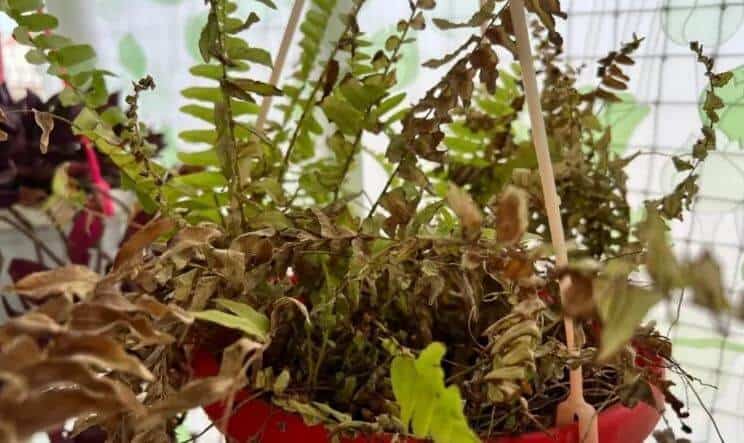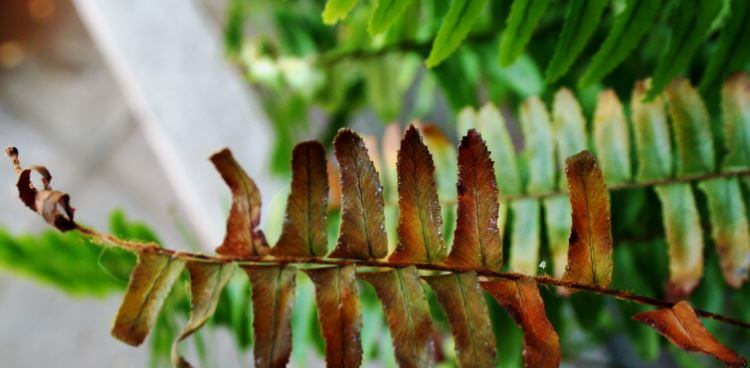Last Updated on January 5, 2023 by a Friendly Gardener
Famous for decorating parlors at the turn of the century, Boston Ferns are elegant plants that bring vibrant greenery to indoor décor. For a happy Boston Fern, you’ll need generous humidity and indirect light to prevent fronds from turning an undesirable brown. Ideal for indoor container cultivation these ferns are relatively easy to care for with the proper environmental conditions.
The Boston Fern, botanically known as the Nephrolepsis Exaltata, is a cultivar of the Sword Fern. This cultivar first appeared in a shipment of these plants dating back to 1894. Now there are numerous fern varieties, but the Boston Fern has maintained its popularity for more than a century. Nonetheless, one of the principal challenges to raising this houseplant is brown leaves on the Boston Fern.
Potential Causes of Boston Fern Leaves Turning Brown

Brown fronds can be caused by a variety of factors from poor soil quality to a lack of humidity to insufficient drainage to name a few. Identifying the true cause is crucial to resolving this issue, so evaluate where your plant is located, outside factors such as house pets, and your care routine.
Environmental Issues
Boston fern leaves turning brown can be due to where your plant is located. Common causes can be identified in the:
• Improper Light

All plants require some degree of light for photosynthesis, the process which ensures nourishment. The Boston Fern thrives best in moderate indirect light producing vivid green fronds. It is sensitive to excessive sunlight where both light and heat can prove to be too much. The frond tips will burn if sunlight is too intense. Select a spot that provides dappled or filtered light.
• Watering Issues
Your Boston fern requires consistent watering to maintain the soil bed moist. Soil should not be soggy or fronds risk turning brown. Underwatering can also harm your plant and presents a much greater risk to your fern. Often brown fronds are due to a lack of water as this plant prefers its root system to be always moist. However, waterlogged soil can lead to root rot. Do not water according to a schedule but rather check the soil for dampness or use a moisture meter. Contributing factors to watering needs will include the season, the container, both type and size, and the soil blend you choose.
• Temperature
Temperature extremes can be a problem for your fern. Ideally, the environmental temperature should measure at approximately 65°F. or between 60° and 75°F. It should not exceed 95°F at any time. Choose a cooler place if possible. Brown fronds can also be the result of temperature extremes or drafts both hot and cold, so avoid heating and air conditioning vents
• Humidity
As a tropical plant, adequate humidity is mandatory when cultivating a Boston Fern. As soon as humidity is low, fronds will begin to turn brown. Your fern needs an environmental humidity of at least 50%. Misting your plant will help as an immediate solution but misting will not resolve humidity issues as the water will evaporate relatively quickly. If you have low indoor humidity, consider a pebble tray underneath your plant or a space humidifier to increase indoor levels. You can also group your fern with other houseplants to raise indoor humidity levels in the area where your plants are positioned. The bathroom is the ideal location for a fern.
Other Potential Causes of Boston Fern Leaves Turning Brown

If the environmental conditions are fine, there may be another cause for fronds turning brown.
• Improper Feeding
The Boston fern can suffer from overfertilization as they are not heavy feeders. Rinse fronds after feeding to avoid the possibility of leaf burn. During the growing season, you can feed your fern every two weeks with liquid plant food for houseplants that have been diluted to half-strength. This feeding routine should be reduced to once monthly in the winter. To encourage the vivid green color of fronds, apply a solution of two tablespoons of Epsom salts per gallon of water twice annually. Keep in mind that fertilizer salts are prone to accumulate in the soil bed and this can cause fronds to brown, and you may need to flush the soil bed several times a year. When applying fertilizer, do so directly to the soil and not to the plant itself.
• A Need for Repotting

Eventually, your plant will require repotting to replace the nutrients in the soil or because it has become rootbound. The plant’s extensive root system can quickly fill the pot and soil. When a Boston Fern becomes rootbound, it will not be able to access enough nourishment or water and fronds will turn brown.
Prepare a blend of two parts peat moss and one part perlite and one part horticultural bark. This will guarantee proper drainage which is essential to your fern’s health. Choose a new pot approximately two inches larger to provide the root system with sufficient room.
• Transplant Shock
If you repot, move your fern to a new container, or propagate using plant division, your fern’s leaves may turn brown because of transplant shock. Transplant shock should never be underestimated as it can be fatal. This occurs when the root system is harmed to some extent.
When transplanting, do so in the late fall or the early spring. Avoid transplanting at the height of the growing system. Treat the roots with care, and after a transplant give your fern time to heal and acclimate.
• Aging Foliage
As your houseplant matures, older fronds will turn brown and eventually fall off. This is a natural process, the only thing to do is prune away older fronds to maintain a nice appearance.
• Acclimation to a New Location

When you first bring your plant home or if you need to change its location within your home, this can cause your Boston fern a bit of stress. If your plant is stressed, it will likely develop brown leaves. Before changing positions, make sure the root system is well-moistened. You can try moving the plant to a new spot for a few hours a day before moving it permanently if possible.

